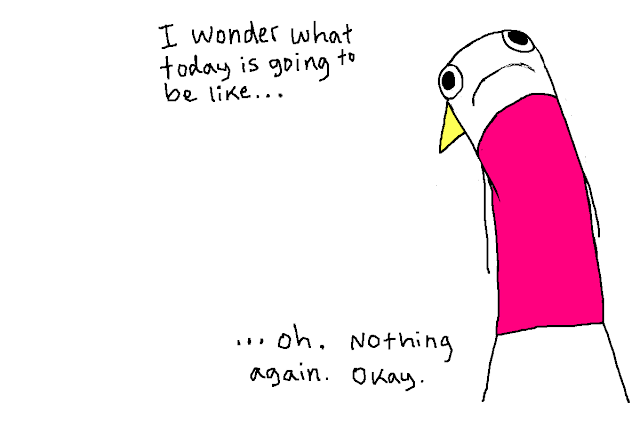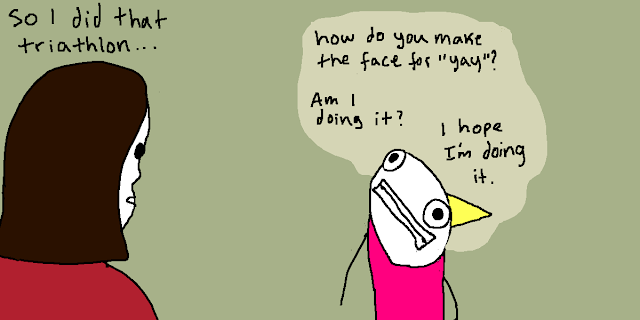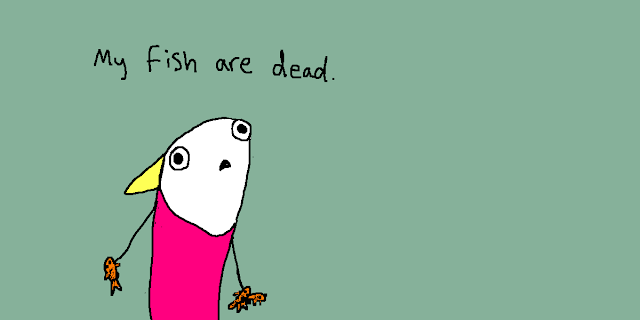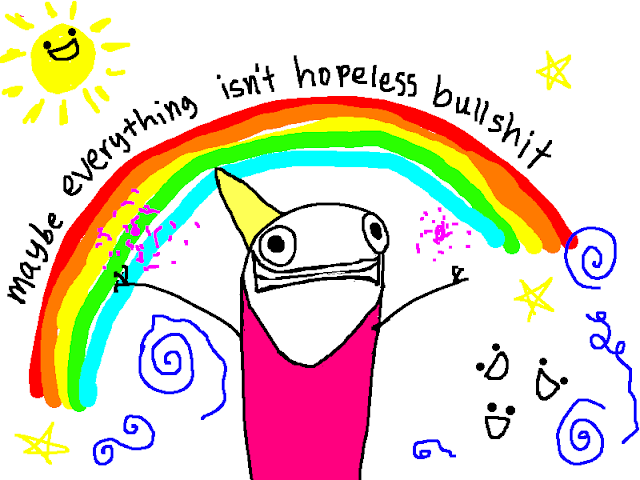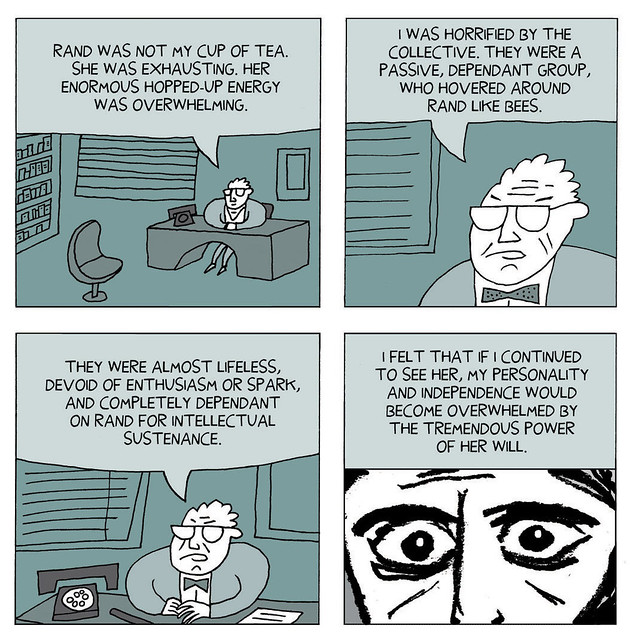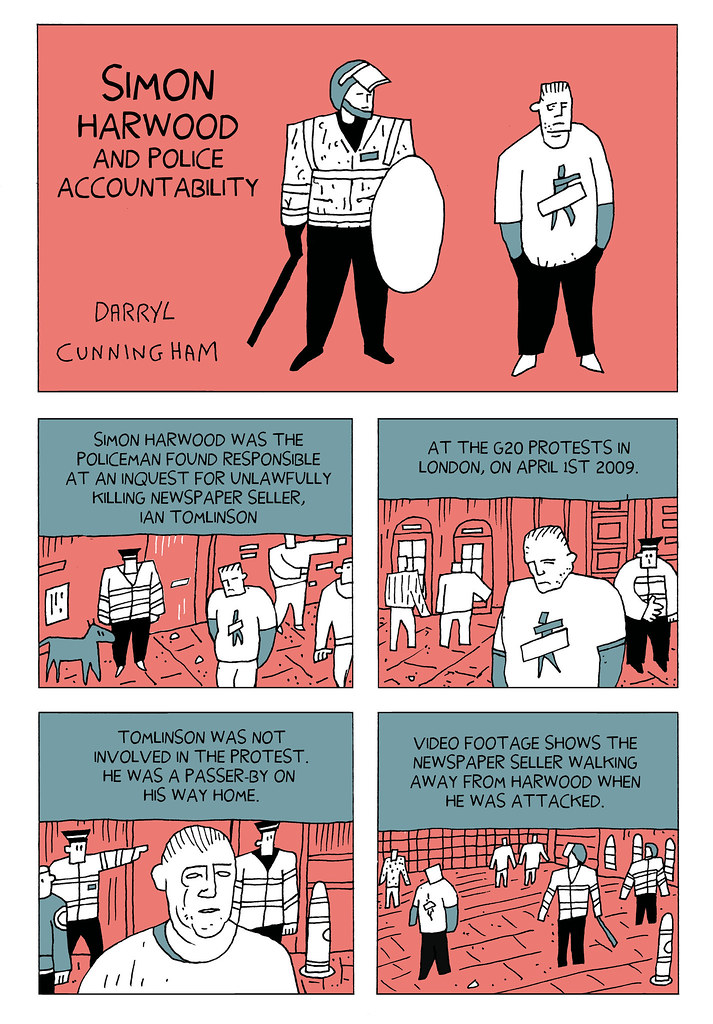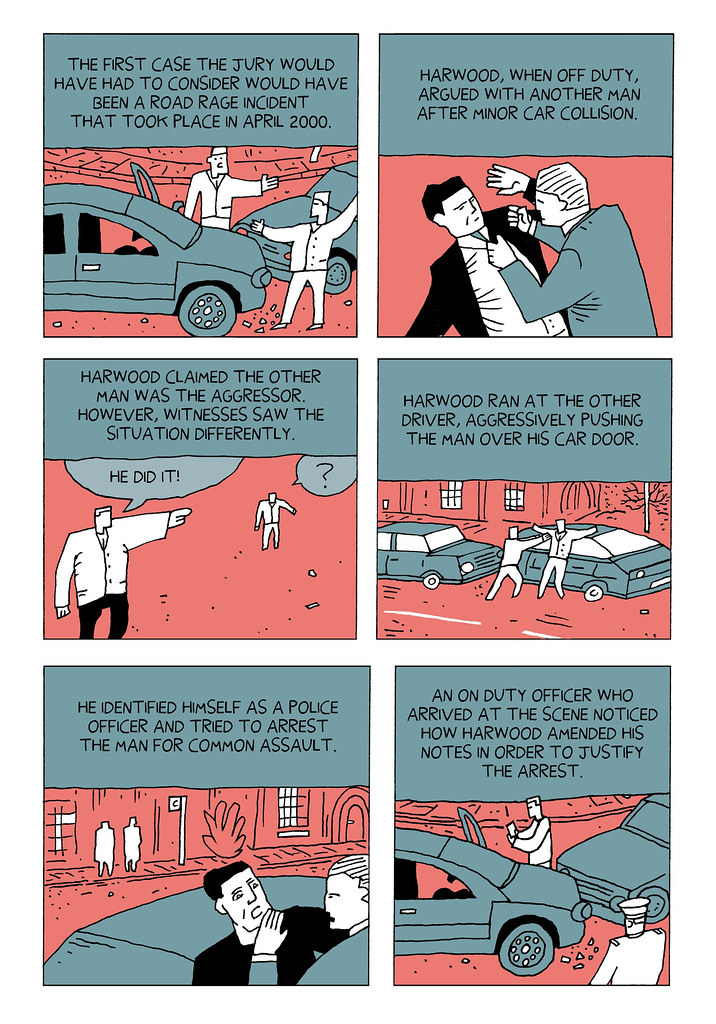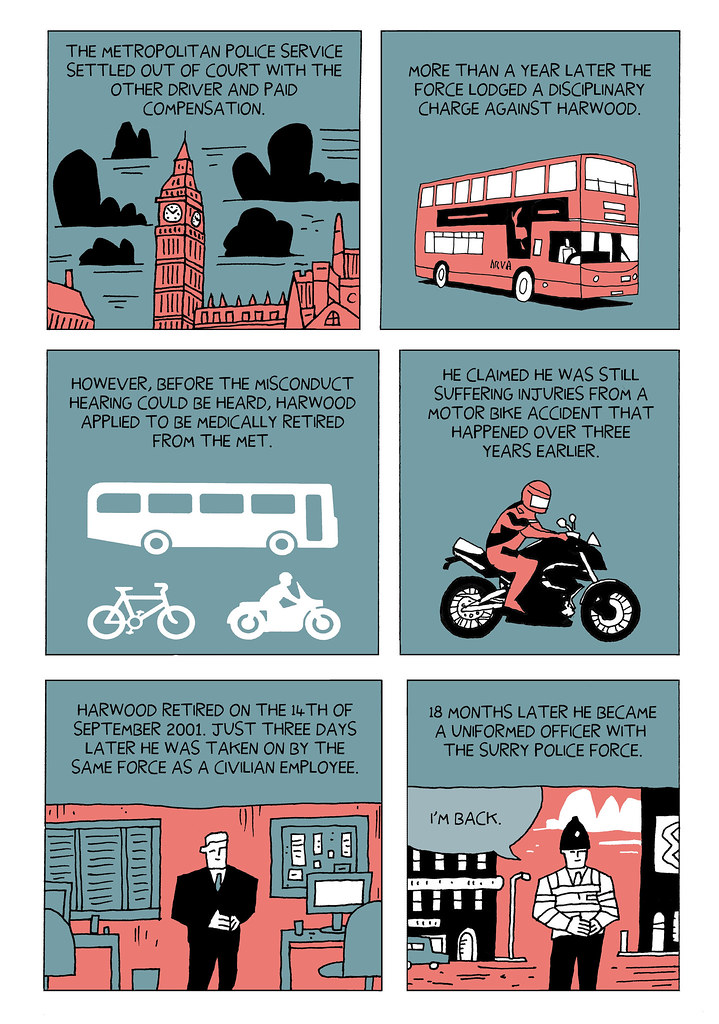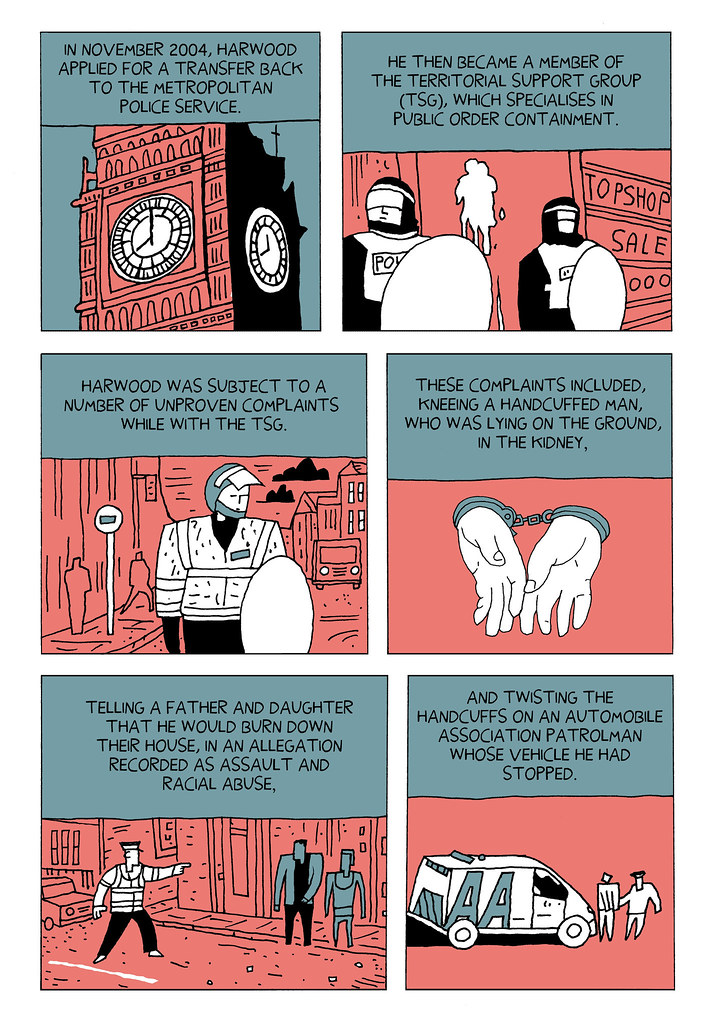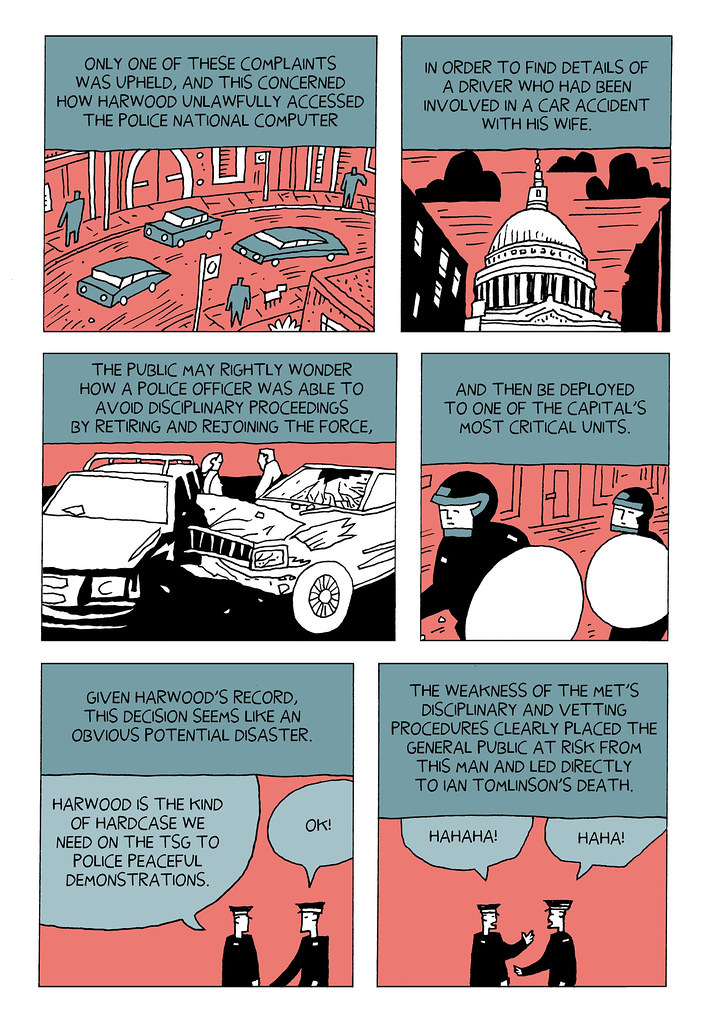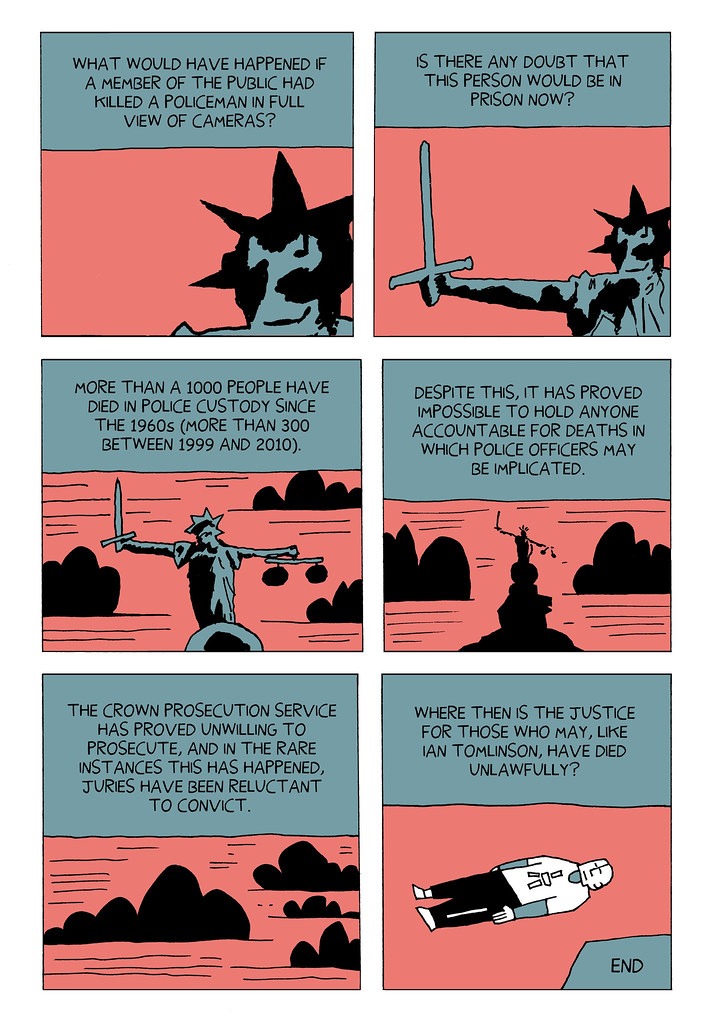Shared posts
Dr. Mike Jacobsen Translates Coke Corporate Speak.
Mike Jacobson is a long time food activist. He's pretty much the Ralph Nader of food. If you've ever read the side of a food package or used the term "junk food" you have Mike to thank. He coined the phrase and has been instrumental in food labeling.
Last week Mike and his Center for Science in the Public Interest released a funny yet scathing film that translates the Coca-Cola company's recent attempt to address obesity. You can check out the film above or on Youtube here.
He's also offered comments and translations of Coke's recent answers to our round of 20 questions.
Is it true a metal nail disappears in a Coke bottle? If so, what does that mean for your body?
Dr. Applebaum: Stories regarding the disappearance of a metal nail are just that —stories. Such legends continue to spring up and get recycled because they’re just too hard to ignore. You may be interested to know that the acids secreted in your stomach to digest foods are stronger than those found in most foods—including a Coca-Cola. In fact, acids in most foods are neutralized to a large degree by the saliva in the mouth long before they reach the stomach.
Dr. Jacobson: Agreed. Last year we tested Coke’s power to dissolve. We put extracted teeth into Coke, water, Sprite, etc. The one in Coke discolored, but never dissolved.
_________________________________________________________________
Are there really 500 + recipes for Coke based on ingredient availability and pricing?
Dr. Applebaum: No. Coca-Cola has the same unique secret recipe everywhere in the world. In some countries the sweetener is table sugar. In others, it’s another type of sugar called high fructose corn syrup. Want to know more about Coca-Cola? Check out: http://www.coca-colacompany.com/brands/product-descriptions#coca-cola
Dr. Jacobson: Judging from tests we conducted last year, except in California, Coca-Cola was made with caramel coloring that had high levels of the carcinogen 4-methylimidazole.
_________________________________________________________________
Do you foresee Coca-Cola labeling their products in North America the same way they are required to in the EU?
Dr. Applebaum: The Coca-Cola Company is committed to providing factual, meaningful and understandable nutrition information about all our products. We believe in the importance and power of informed choice and we label our products in line with government regulations in the countries where they are sold, often going beyond what is required by regulation.
In September 2009, we were the first beverage company to make a global commitment to place front-of-pack calorie information on nearly all of our packages by the end of 2011. And we met that target! Front-of-pack calorie labeling makes it easier for consumers to identify the amount of calories in our products. http://www.thecoca-colacompany.com/ourcompany/hal_policy_nutritional_labeling.html.
Dr. Jacobson: The label on a can of British Coke is quite similar to the U.S. label, except that it has those pretty-useless GDA graphics. “Informed choice”? Coke spends billions of dollars a year promoting its sugary drinks, but never reminds consumers that drinking too much of them promotes obesity, diabetes, heart disease, gout, and tooth decay.
_________________________________________________________________
Coke gets knocked a lot for being unhealthy. Any unheard of benefits to drinking it? Would make pleasure less guilty.
Dr. Applebaum: My personal point of view, there are no unhealthy foods or beverages—only unhealthy diets. I realize not all agree. To that end, my personal view is there’s nothing “unhealthy” about a Coke. A Coke is refreshing, it hydrates and it tastes good. Yes it has calories—clearly labeled—and all of us need to make sure we are mindful about managing our calories. As with the diet in total—it’s about the how, how much and how often. The calories in a Coke come from carbs (sugars), which are essential for life. But carbs as we know are a source of calories, so it is important to remember that all calories count when it comes to a healthy weight.
As far as ‘pleasure with less guilt’ do not hesitate to try our diet beverages—Coke Zero has a great Coca-Cola taste, but no calories. You can also enjoy a smaller portion of Coke—our 7.5 oz. can is only 90 calories. As for me, no guilt—but I also am mindful of my total caloric intake. To that end (and to borrow from a favorite Coca-Cola tagline, the “pause that refreshes”)—I have a ‘refreshing pause’ every afternoon around 3 or 4 pm.
Dr. Jacobson: She forgot to mention that a Coke also has about 16 teaspoons of sugars from high-fructose corn syrup in every 20-oz. bottle.
In NYC Coke says that consumers should have the right to decide for themselves on portion. In California you fought consumer labeling of GMO. Why?
Dr. Applebaum: I refer the tweeter to the response to GMO and Prop 37 in the first question. Prop 37 was not a referendum on the right to decide or choose GMO-free products—they already can choose to purchase such foods/beverages by looking for organic or GMO-free labels. Since this is an attribute some consumers actively look for, companies readily proclaim/label same when they can meet the criteria for organic and/or GMO-free. To that end, it’s a good bet that products that are not labeled GMO-free, contain an ingredient that is derived via biotechnology (although frequently in a very distant way). Regardless of whether the product contain or does not contain GMO—all are safe—and that needs to emphasized at every opportunity so the public does not needlessly worry about consuming products that contain a GMO ingredient—especially moms, dads and care givers who may not be able to buy organic or GMO-free. In short, we believe in consumer choice and thus GMO-free products are labeled to make this clear to consumers and to guide their decisions if they so choose.
Dr. Jacobson: One amusing thing about her defensiveness is that the high-fructose corn syrup and sugar used in Coke products are such pure carbohydrates that they don’t contain any genetically engineered DNA or protein. Coke could honestly say that their products are GMO-free.
_________________________________________________________________
Why is Coke in a glass bottle so darn good?
Dr. Applebaum: Coffee in a china cup, a frosty mug for beer, ice cream in a cone, Coke in a glass bottle. Some things simply have no explanation as to why they “belong” together. They just do! “Check out this survey on our website to see if others agree with you ϑ http://www.coca-colacompany.com/debates/fountain-vs-bottle-best-way-to-order-a-soft-drink
Dr. Jacobson: Speaking of websites - people would learn more by checking out our website that provides some honest information about the health impact of soft drinks.
_________________________________________________________________
Do soft drink companies have a responsibility re: U.S. obesity epidemic or is it just a matter of personal individual responsibility?
Dr. Applebaum: It’s both.
Obesity is a serious and complex issue and there are no simple answers. Effective solutions need to come from everyone working together – you, me, governments, businesses, health professionals and individuals.
Coca-Cola takes its responsibility in this area very seriously. From our broad portfolio of beverages that offer consumers options to meet individual needs, to our innovations in the use of low- and no-calories sweeteners, the introductions of smaller portion-size packaging, our transparent ingredient and nutrition information, our Global Responsible Marketing Policy and our support for physical activity and nutrition education programs all over the world, we are constantly striving to do our part to help stem the tide of obesity.
But consumers also have a responsibility to make the right choices for themselves and their families and to do that they need the necessary information, a firm understanding of what it takes to achieve active, healthy lifestyles, and the opportunities to make these choices. This includes things such as understanding the concept of calories, energy balance, the importance and benefits of regular physical activity and the basics for assembling a sensible balanced diet.
Dr. Jacobson: She says there are no simple answers but actually, there are some simple answers, such as not drinking regular soft drinks, energy drinks, fruit drinks, and sports drinks, all of which are loaded with calories, along with a flock of questionable food additives (caffeine, artificial caramel coloring, food dyes, and phosphoric acid).
When they speak of responsibility it's good to remember that Coke’s primary responsibility is to its stockholders, and it certainly takes that very seriously.
And the money they put into "nutrition education" is dwafed by the billions of dollars behind the marketing of sugar drinks.
_________________________________________________________________
How does the Coca-Cola Company (and Dr. Applebaum personally) align, express and transmit values & #ethics to its staff and the public?
Dr. Applebaum: We are focused on positively impacting all of the communities we serve. Because of this, we demand integrity in every aspect of our business. Transparency, authenticity and accountability are our most closely held values. Our Company’s Code of Business Conduct guides our expectation of accountability, honesty and integrity from our business and from our employees. All Company associates are required to follow the Code in the workplace and in the community. Read about our Code of Business Conduct in our 2011/2012 Sustainability Report: http://www.coca-colacompany.com/sustainabilityreport/downloads/2012-sustainability-report.pdf
For me personally, my values, my beliefs and faith guide what I do. My integrity, my credibility, my reputation are very important to me and I would never do anything to jeopardize them. To that end, I strive to ‘walk the talk’, ‘practice what I preach’ and avoid, at all cost, being a hypocrite and compromising my values and ethics. Lord knows I’m not perfect, and I make that clear, but I do my best to be honest and real—in everything I do—both at work and in my personal life.
Dr. Jacobson: "impacting communities they serve" ...including giving money to nonprofit civic and health groups, which has the benefit of discouraging them from criticizing Coca-Cola Co. (witness the NY State NAACP’s recent attack on New York City’s regulation to limit the size of Cokes and other soft drinks sold at restaurants, stadiums, and other venues.
_________________________________________________________________
What role can Coke play in moving people to smaller portion sizes?
Dr. Applebaum: We know people want a wide variety of beverages and packages to meet their needs for refreshment, enjoyment, nutrition and hydration. In certain markets, we are offering more variety in our packaging to help consumers manage their calorie intake and energy balance. In 2011, we began offering more beverages in the U.S. in our 7.5-fl. oz. mini-cans, which provide 0-100 calories depending on the beverage. Coke, Diet Coke, Coke Zero, Sprite, Fanta, Barq’s and Seagram’s Ginger Ale are now all available in mini-cans. Some products are also available in mini-cans in Australia, Canada, Korea and Thailand. In more than 125 countries, we also offer glass bottles of many of our sparkling beverages in bottles that are 250 ml (8 oz.) or less. For more info-- http://www.coca-colacompany.com/sustainabilityreport/downloads/2012-sustainability-report.pdf
Dr. Jacobson: It's worth noting that cans of Coke are already seven percent smaller in Europe and the Middle East (and some other countries) than the United States.
_________________________________________________________________
Given the obesity issue, why hasn't Coke publicly set goals for increasing sales of water and low calorie bevs and reducing sales of high cal drinks?
Dr. Applebaum: In the U.S. and around the world, Coca-Cola is at the forefront of efforts to help reduce the incidence of obesity. We believe to achieve successful outcomes, not one sector can do it alone. To succeed we need to work across the ‘Golden Triangle’—business, government and civil society. Collaborations and partnerships—engagement and working together—are the key, the catalysts for positive change. Just a few of our actions -
- The Healthy Weight Commitment in the U.S., where we’ve joined a broad coalition of stakeholders, focused on bringing a common-sense approach to helping reduce obesity by 2015. A key goal for its members is to collectively reduce 1.5 trillion calories from America’s diet. Read more at http://www.healthyweightcommit.org/
- Our policy and commitment to place calories on the front of nearly all of our packages, globally, providing consumers with fact-based information from which they can make beverages choice to meet individual need: http://www.coca-colacompany.com/brands/policy-on-nutrition-labeling-and-nutrition-information
- Exercise is MedicineTM,, where we are a founding partner of this program of the American College of Sports Medicine. EIM calls upon physicians to record physical activity as a vital sign during patient visits and to advise able patients to participate in at least 30 minutes of physical activity and 10 minutes of stretching and light muscle training five days a week.
- Also the founding member of EPODE Int’l Network—its mission--to reduce childhood obesity prevalence through sustainable strategies based on Community Based Programs (CBPs). http://www.epode-international-network.com/
- Our support of more than 280 physical activity and nutrition education programs in over 115 countries around the world.
When it comes to low- and no-calorie beverages, we work very hard to bring consumers choices in beverages that can help manage calories. So thank you for that important call out, because beverages are the only food (except for gum) that can give you great taste, with and without calories. Read more about our efforts in Our Position on Obesity and Well-being Facts: http://d1lwft0f0qzya1.cloudfront.net/9b/62/c661da674cc690db3ccad9195639/obesity-position-statement.pdf
Dr. Jacobson: Actually, that’s not quite true. A company like Coke could reduce the incidence of Coke by not advertising its high-calorie drinks or by charging more for them.
_________________________________________________________________
Even the FDA has admitted that dyes trigger hyperactivity and other problems in children. Why won't Coke eliminate dyes from all its products?
Dr. Applebaum: The FDA has not stated that dyes trigger hyperactivity. Here’s what they said, “Although this hypothesis was popularized in the 1970's, results from studies on this issue either have been inconclusive, inconsistent, or difficult to interpret due to inadequacies in study design.” In addition, FDA evaluated recent European research that alleges a link between food colors and hyperactivity and found “that the study does not substantiate a link between the color additives that were tested and behavioral effects.” For more information: http://www.fda.gov/Food/FoodIngredientsPackaging/ucm094211.htm#qahyper
Dr. Jacobson: This, actually, is not true. In March 2011 the FDA acknowledged that dyes trigger hyperactivity in some children: "Based on our review of the data from the published literature, FDA concludes that a causal relationship between exposure to color additives and hyperactivity in children in the general population has not been established. For certain susceptible children with Attention Deficit/Hyperactivity Disorder and other problem behaviors, however, the data suggest that their condition may be exacerbated by exposure to a number of substances in food, including, but not limited to, synthetic color additives. Findings from relevant clinical trials indicate that the effects on their behavior appear to be due to a unique intolerance to these substances and not to any inherent neurotoxic properties."”
The study was convincing enough to persuade the British government to urge food manufacturers to stop using the half-dozen dyes used in the study. Also, the study was done on average kids, not ones with hyperactivity or ADHD. Ms. Applebaum shouldn’t pretend that the study disproved the link between dyes and behavioral problems in children with hyperactivity.
_________________________________________________________________
How much coke a day should a teenager drink…if we want to prevent overweight in view of sedentarism?
Dr. Applebaum: When it comes to teens, energy balance – the balance between calories in from foods and beverages and calories out from physical activity - is what is most important along with a balanced, sensible and varied diet to support normal growth and development. According to USDA food patterns, active teenagers, particularly males, have the highest energy needs. Thus, an active teenager may be able to meet nutrient needs and have several hundred calories that can come from other foods and beverages –what are called “discretionary” calories—to meet total energy/calorie needs. If a teen is sedentary, overall food choices, along with recommendations to increase physical activity and reduce sedentary behaviors (screen time, television, etc.), will most benefit overall health and development and promote weight management. This also will help establish life-long healthful lifestyle habits. For more information, see Appendices 6 and 7 of the 2010 Dietary Guidelines for Americans, pages 78-79. Discretionary calories from solid fats and added sugars for active teen boys can be about 600 calories. That’s room enough for two, 20 fl. oz. bottles of Coca-Cola, and maybe a cookie. http://www.cnpp.usda.gov/dietaryguidelines.htm
And yes, I let my 16-year-old son—soon to be 17--drink Coke and our other beverages (another of his favorites is Honest Tea)—but as part of a healthy diet. And I also make sure he gets plenty of physical activity and sleep—for his health—body, mind and spirit—and my sanity ϑ
Dr. Jacobson: 600 calories is supposed to include all the extra fats and sugars that that active male would consume. Assuming that half of those calories are allotted to sugar, an active boy could drink one 20-oz. bottle. But most boys are not active; assuming even that they are “moderately active,” that would permit only 400 calories for fat/sugar, or 200 calories for sugar, or one can of Coke plus “maybe a cookie”—but no more added sugars all day from ice cream, breakfast cereals, baked goods, and all the rest.
_________________________________________________________________
Caramel coloring contains cancer-causing 4-MEI and California forced a change. When will the less contaminated product be available everywhere?
Dr. Applebaum: There is no evidence from studies involving humans that 4-MEI causes cancer. Scientific experts, like the European Food Safety Authority, the U.S. Food and Drug Administration, and Health Canada, who have looked at the totality of the evidence have said that consumers are not at risk from the small amounts of 4-MEI in caramel coloring. The change in California was caused by a “right to know” law where the merits for listing 4-MEI were not reviewed by independent scientists as requested by the beverage industry.
The safety of our beverages is demonstrated by the fact that no regulatory agency around the world has either taken them off the market or has requested that we change the caramel we use. Nevertheless in order to avoid putting an unwarranted warning label on our products in California, we asked our caramel color suppliers to determine how to reduce the levels of 4-MEI in the caramel color while maintaining the characteristics of caramel.
Products currently available in California are made with the new process caramel. In order to ensure that consumers continue to be able to enjoy the same great taste of our products everywhere, products with the new caramel color will be rolled out nationally as the supply of new process caramel becomes more available.
But to be perfectly clear—if our beverages were unsafe—they wouldn’t be able to be sold—not in CA or anywhere. To repeat the CA law (Prop 65) is about labeling—not about safety.
Dr. Jacobson: This answer is total malarkey. There’s general agreement among cancer scientists at the U.S. National Toxicology Program and the International Agency for Research on Cancer, that 4-MEI is a carcinogen. The state of California’s scientists, who are independent of Coke’s dollars, concluded that it causes an excessive cancer risk in humans. The FDA, as usual, has been asleep at the wheel. True…and shame on those agencies. California required a warning label, but Coke (and Pepsi) switched to a safer caramel coloring. I hope that Coca-Cola makes that change for the rest of the world (more Coke is sold outside than inside the United States).
_________________________________________________________________
Soda is the #1 source of calories in the US diet. Caffeine is an addictive stimulant added to bevs that millions of children consume. Why not just eliminate caffeine?
Dr. Applebaum: Let me take each in order, beginning first with calories. Actually, NHANES (National Health and Nutrition Examination Survey) data 2001-2002 to 2009-2010 show that grain-mixtures (p)izza, tacos, burritos, and other foods that combine numerous ingredients, but are predominantly grains are the number one source of calories in the U.S. diet and have remained so over the last 10 years.
Based on analyses of usual dietary intakes conducted by the U.S. National Cancer Institute, sodas, energy drinks, sports drinks, sweetened water beverages (including those with added nutrients), and fruit drinks combined comprise on average nearly 7% of all calories consumed by Americans – which means that 93% of our calories come from other sources. (USDA and DHHS, 2010) However, there are age, gender and ethnic groups in the population that have higher or lower intakes of calories from beverages.
Regardless, it is important to remember that all foods and beverages have the potential of contributing excess calories to the diet—thus consumers must be mindful of the total amount of calories they consume.
And now the 2nd part of your question-- caffeine. The Coca-Cola Company has used caffeine as a safe ingredient for more than 126 years. And as it relates to addiction…foods and beverages aren’t drugs. The term “addiction” is often used loosely in the press, online and in everyday conversations in relationship to good tasting foods and beverages that people like to consume on a frequent basis. “Substance dependence” is the term used by many experts in the field to describe true addictions.
While caffeine is known to be a mild stimulant, both Health Canada and the U.S. FDA have found levels up to 400 mg per day to be safe for healthy adults. Many health professionals consider 300-400 mg per day to be a moderate level of consumption for an adult (the approximate amount in three or four cups of coffee or seven to nine cans of caffeinated sparkling beverage).
Lastly, we label caffeine levels on our products (in the U.S. and where permitted elsewhere in the world) and we also have a wide variety of caffeine-free beverages for those who do not want to consume caffeine or give to their children. Why? Because we believe in consumer choice—some folks want caffeine, some don’t. Choice.
Dr. Jacobson: To be “perfectly clear,” the law concerns the labeling of unsafe products. People can decide whether it’s fair to lump pizzas, tacos, and all those other foods together. The fact is, Americans (and Mexicans and others) consume such huge amounts of sugary drinks that they suffer a range of health consequences (not that pizza and tacos are health foods).
_________________________________________________________________
What are the human health benefits of HFCS over cane sugar?
Dr. Applebaum: In short, there is no difference from a benefit perspective between HFCS vs. cane sugar—they’re essentially the same. Both are carbohydrates, providing 4 calories per gram with similar proportions of glucose and fructose. When it comes to satisfying your appetite, HFCS is equivalent to cane sugar. In fact, two 2007 studies comparing sparkling beverages sweetened with HFCS or sugar showed no difference in hunger, satiety or short-term energy intake (Melanson 2007; Monsivais 2007). For more information, check The Coca-Cola Company Beverage Institute for Health and Wellness: http://www.beverageinstitute.org/en_US/pages/article-science-hfcs.html, or the Corn Refiners Association: http://sweetsurprise.com/hfcs-faqs?utm_source=google&utm_medium=cpc&utm_term=what%20is%20high%20fructose%20corn%20syrup&utm_campaign=Facts&gclid=CPvQ__6J_7MCFQSqnQodNWYAHA
Dr. Jacobson: No different…but beverages do not promote satiety (are not as filling) as foods, which is one major reason why soft drinks promote obesity.
We Play 20 Questions With Coke's Lead Scientist.
 A few months ago, FearLess, COMMON, The Butler Bros, Jason Mraz and the Center for Science in the Public Interest (CSPI) launched a joint film production and site called therealbears.org. The film followed a family of Soda-loving Polar Bears that winds up having the same issues with sugary drinks that many of us in real life are having: obesity, diabetes, and the complications that come with them.
A few months ago, FearLess, COMMON, The Butler Bros, Jason Mraz and the Center for Science in the Public Interest (CSPI) launched a joint film production and site called therealbears.org. The film followed a family of Soda-loving Polar Bears that winds up having the same issues with sugary drinks that many of us in real life are having: obesity, diabetes, and the complications that come with them.
The Coca-Cola company was quick to reach out to me in an effort to get me up to speed "on all the good work they are doing." At the time I had no idea they were about to attempt to enter the conversation on obesity. You can see their film here and you can see a translation of the corp. speak here.
A lunch was set up with their lead scientist, Dr. Rhona Applebaum. I showed up on time but she was early and had already taken a seat in the back. It took me a while to find her sittling at a tiny tabel by the window. My first impression was that Dr. Applebaum is perfectly cast for her role. She is a smart, articulate, thin, attractive and immaculately put together middle-aged woman who is in control of her emotions at all times. We ordered our lunch and began the search for common ground. I wish I could remember what she ordered to drink but I don't. It was either water or a Diet Coke.
I don't think we found much to agree on in terms of GMOs, HFCS, Obesity or anything else. The conversation stayed friendly but it never got very real. There was a brief moment when I did get the sense that Dr. Applebaum felt that they had fought too much against the NYC limits on portion sizes. But that was only my sense and she never actually voiced those words. She also offered several introductions to the CEOs at some of the more healthy brands they had acquired. That was incredibly nice but I didn't pursue this line of conversation because it made me a bit uncomfortable. It felt like a carrot being dangled but perhaps it was nothing more than a nice gesture.
Via twitter I collected a bunch of questions that people wanted to ask of Coke and during lunch Rhona agreed to answer them. Some are easy and silly. Others are more to the point. Below are the questions and answers unedited.
I want to thank FearLess readers for their questions and Dr. Applebaum for her time and willingness to answer all our questions. It's tempting to dissect some of the answers but getting the dialog going it more important right now. So it's Q and A time!
Make your own conclusion.
1: Why did Coke fund the advertising to defeat Prop37?
Along with many other sectors, including the food and beverage sector, we supported actions to defeat Prop 37. I won’t run down the concerns Prop 37 presented—they can be found at this website http://www.noprop37.com/. But as someone who has been engaged in the labeling issue for over two decades, and to keep this answer short, here are two reasons:
- The Proposition was unnecessary. For those who do not want GMO ingredients, labeling such as ‘organic’ and ‘contains no GMO’ is already available, as are a number of web sites identifying what foods/bevs do not contain GMO; and
- We believe such information did not constitute material information or information of consequence ( e.g., it has no bearing on safety). The best example I can give is the required labeling for the presence of allergens. We label the presence of allergens to make sure allergic individuals have the necessary information to avoid these products vs. labeling the overwhelming majority of packaged food products that contain no allergens. GMO as a process does not present a safety risk, thus to require it to be labeled we believed does nothing to further the interest of public health.
2: Is it true a metal nail disappears in a Coke bottle? If so, what does that mean for your body?
Stories regarding the disappearance of a metal nail are just that —stories. Such legends continue to spring up and get recycled because they’re just too hard to ignore. You may be interested to know that the acids secreted in your stomach to digest foods are stronger than those found in most foods—including a Coca-Cola. In fact, acids in most foods are neutralized to a large degree by the saliva in the mouth long before they reach the stomach.
3: Are there really 500 + recipes for Coke based on ingredient availability and pricing?
No. Coca-Cola has the same unique secret recipe everywhere in the world. In some countries the sweetener is table sugar. In others, it’s another type of sugar called high fructose corn syrup. Want to know more about Coca-Cola? Check out: http://www.coca-colacompany.com/brands/product-descriptions#coca-cola
4: Do you foresee Coca-Cola labeling their products in North America the same way they are required to in the EU?
The Coca-Cola Company is committed to providing factual, meaningful and understandable nutrition information about all our products. We believe in the importance and power of informed choice and we label our products in line with government regulations in the countries where they are sold, often going beyond what is required by regulation.
In September 2009, we were the first beverage company to make a global commitment to place front-of-pack calorie information on nearly all of our packages by the end of 2011. And we met that target! Front-of-pack calorie labeling makes it easier for consumers to identify the amount of calories in our products. http://www.thecoca-colacompany.com/ourcompany/hal_policy_nutritional_labeling.html.
5: Does she have kids and if so, at what age was she comfortable with them drinking soda + how much?
Yes, I have a 16 year old and I’ve allowed him to enjoy our beverages—including Coke since he was small, but my husband and I were the ones who determined how, how much and how often—and of course when.
Now that he’s a teenager, he continues to enjoy our beverages, but I make sure his beverage intake—and his diet in total—is sensible, varied, and balanced, that he’s getting his nutritional needs met and that he exercises regularly. That’s my job as his Mom to give him the basics on the importance of an active, healthy lifestyle.
When it comes to children, we respect the rights of parents and care givers to choose what’s best for their children—and we want them to have the necessary information and understanding to make informed choices. That’s why we don’t market to kids under 12 and why we joined other beverage companies in the U.S. to remove full calorie beverages from schools. For more information: http://www.coca-colacompany.com/stories/responsible-marketing; http://www.ameribev.org/nutrition--science/school-beverage-guidelines/
By the way, when it comes to raising children, the best quote that summarizes my philosophy is from Margaret Mead--“Children must be taught how to think, not what to think.” I have and continue to apply this philosophy to my son—it’s the best gift and preparation I can give him—along with lots of love.
6: Coke gets knocked a lot for being unhealthy. Any unheard of benefits to drinking it? Would make pleasure less guilty.
My personal point of view, there are no unhealthy foods or beverages—only unhealthy diets. I realize not all agree. To that end, my personal view is there’s nothing “unhealthy” about a Coke. A Coke is refreshing, it hydrates and it tastes good. Yes it has calories—clearly labeled—and all of us need to make sure we are mindful about managing our calories. As with the diet in total—it’s about the how, how much and how often. The calories in a Coke come from carbs (sugars), which are essential for life. But carbs as we know are a source of calories, so it is important to remember that all calories count when it comes to a healthy weight.
As far as ‘pleasure with less guilt’ do not hesitate to try our diet beverages—Coke Zero has a great Coca-Cola taste, but no calories. You can also enjoy a smaller portion of Coke—our 7.5 oz. can is only 90 calories. As for me, no guilt—but I also am mindful of my total caloric intake. To that end (and to borrow from a favorite Coca-Cola tagline, the “pause that refreshes”)—I have a ‘refreshing pause’ every afternoon around 3 or 4 pm.
7: In NYC Coke says that consumers should have the right to decide for themselves on portion. In California you fought consumer labeling of GMO. Why?
I refer the tweeter to the response to GMO and Prop 37 in the first question. Prop 37 was not a referendum on the right to decide or choose GMO-free products—they already can choose to purchase such foods/beverages by looking for organic or GMO-free labels. Since this is an attribute some consumers actively look for, companies readily proclaim/label same when they can meet the criteria for organic and/or GMO-free. To that end, it’s a good bet that products that are not labeled GMO-free, contain an ingredient that is derived via biotechnology (although frequently in a very distant way). Regardless of whether the product contain or does not contain GMO—all are safe—and that needs to emphasized at every opportunity so the public does not needlessly worry about consuming products that contain a GMO ingredient—especially moms, dads and care givers who may not be able to buy organic or GMO-free. In short, we believe in consumer choice and thus GMO-free products are labeled to make this clear to consumers and to guide their decisions if they so choose.
8: Why is Coke in a glass bottle so darn good?
Coffee in a china cup, a frosty mug for beer, ice cream in a cone, Coke in a glass bottle. Some things simply have no explanation as to why they “belong” together. They just do! “Check out this survey on our website to see if others agree with you http://www.coca-colacompany.com/debates/fountain-vs-bottle-best-way-to-order-a-soft-drink
9: Do soft drink companies have a responsibility re: U.S. obesity epidemic or is it just a matter of personal individual responsibility?
It’s both.
Obesity is a serious and complex issue and there are no simple answers. Effective solutions need to come from everyone working together – you, me, governments, businesses, health professionals and individuals.
Coca-Cola takes its responsibility in this area very seriously. From our broad portfolio of beverages that offer consumers options to meet individual needs, to our innovations in the use of low- and no-calories sweeteners, the introductions of smaller portion-size packaging, our transparent ingredient and nutrition information, our Global Responsible Marketing Policy and our support for physical activity and nutrition education programs all over the world, we are constantly striving to do our part to help stem the tide of obesity.
But consumers also have a responsibility to make the right choices for themselves and their families and to do that they need the necessary information, a firm understanding of what it takes to achieve active, healthy lifestyles, and the opportunities to make these choices. This includes things such as understanding the concept of calories, energy balance, the importance and benefits of regular physical activity and the basics for assembling a sensible balanced diet.
10: How does the Coca-Cola Company (and Dr. Applebaum personally) align, express and transmit values & #ethics to its staff and the public?
We are focused on positively impacting all of the communities we serve. Because of this, we demand integrity in every aspect of our business. Transparency, authenticity and accountability are our most closely held values. Our Company’s Code of Business Conduct guides our expectation of accountability, honesty and integrity from our business and from our employees. All Company associates are required to follow the Code in the workplace and in the community. Read about our Code of Business Conduct in our 2011/2012 Sustainability Report: http://www.coca-colacompany.com/sustainabilityreport/downloads/2012-sustainability-report.pdf
For me personally, my values, my beliefs and faith guide what I do. My integrity, my credibility, my reputation are very important to me and I would never do anything to jeopardize them. To that end, I strive to ‘walk the talk’, ‘practice what I preach’ and avoid, at all cost, being a hypocrite and compromising my values and ethics. Lord knows I’m not perfect, and I make that clear, but I do my best to be honest and real—in everything I do—both at work and in my personal life.
11: Why can’t they make a cola with maybe 10g of cane sugar instead of a mound of HFCS? *NO* sugar substitutes.
We are dedicated to providing you with the same great-tasting, refreshing, high-quality products that we have been serving for 126 years. As people’s tastes and needs change we offer products that change right along with them. We believe in providing you with a choice in beverages and are always looking for ways to meet consumer demand. Currently we have 23 different “Coca-Cola trademark products” including Coca-Cola, Coca-Cola Light, Diet Coke, Coke Zero, Caffeine-Free Coca-Cola, Caffeine-Free Diet Coke and Cherry Coke. Check out our full product list: http://www.coca-colacompany.com/brands/all.
I know this isn’t your question, but I feel I need to say that all of our ingredients, including sugar, HFCS and low- and no-calorie sweeteners are safe. I also understand you as an individual have your preferences. With that—I will share your request, but to be honest, not sure if 10 g. of sugar in a 12 oz. portion of Coke will meet your expectations. Will test it for you and get back.
12: What role can Coke play in moving people to smaller portion sizes?
We know people want a wide variety of beverages and packages to meet their needs for refreshment, enjoyment, nutrition and hydration. In certain markets, we are offering more variety in our packaging to help consumers manage their calorie intake and energy balance. In 2011, we began offering more beverages in the U.S. in our 7.5-fl. oz. mini-cans, which provide 0-100 calories depending on the beverage. Coke, Diet Coke, Coke Zero, Sprite, Fanta, Barq’s and Seagram’s Ginger Ale are now all available in mini-cans. Some products are also available in mini-cans in Australia, Canada, Korea and Thailand. In more than 125 countries, we also offer glass bottles of many of our sparkling beverages in bottles that are 250 ml (8 oz.) or less. For more info-- http://www.coca-colacompany.com/sustainabilityreport/downloads/2012-sustainability-report.pdf
13. Given the obesity issue, why hasn't Coke publicly set goals for increasing sales of water and low calorie bevs and reducing sales of high cal drinks?
In the U.S. and around the world, Coca-Cola is at the forefront of efforts to help reduce the incidence of obesity. We believe to achieve successful outcomes, not one sector can do it alone. To succeed we need to work across the ‘Golden Triangle’—business, government and civil society. Collaborations and partnerships—engagement and working together—are the key, the catalysts for positive change. Just a few of our actions -
- The Healthy Weight Commitment in the U.S., where we’ve joined a broad coalition of stakeholders, focused on bringing a common-sense approach to helping reduce obesity by 2015. A key goal for its members is to collectively reduce 1.5 trillion calories from America’s diet. Read more at http://www.healthyweightcommit.org/
- Our policy and commitment to place calories on the front of nearly all of our packages, globally, providing consumers with fact-based information from which they can make beverages choice to meet individual need: http://www.coca-colacompany.com/brands/policy-on-nutrition-labeling-and-nutrition-information
- Exercise is MedicineTM,, where we are a founding partner of this program of the American College of Sports Medicine. EIM calls upon physicians to record physical activity as a vital sign during patient visits and to advise able patients to participate in at least 30 minutes of physical activity and 10 minutes of stretching and light muscle training five days a week.
- Also the founding member of EPODE Int’l Network—its mission--to reduce childhood obesity prevalence through sustainable strategies based on Community Based Programs (CBPs). http://www.epode-international-network.com/
- Our support of more than 280 physical activity and nutrition education programs in over 115 countries around the world.
When it comes to low- and no-calorie beverages, we work very hard to bring consumers choices in beverages that can help manage calories. So thank you for that important call out, because beverages are the only food (except for gum) that can give you great taste, with and without calories. Read more about our efforts in Our Position on Obesity and Well-being Facts: http://d1lwft0f0qzya1.cloudfront.net/9b/62/c661da674cc690db3ccad9195639/obesity-position-statement.pdf
14: Even the FDA has admitted that dyes trigger hyperactivity and other problems in children. Why won't Coke eliminate dyes from all its products?
The FDA has not stated that dyes trigger hyperactivity. Here’s what they said, “Although this hypothesis was popularized in the 1970's, results from studies on this issue either have been inconclusive, inconsistent, or difficult to interpret due to inadequacies in study design.” In addition, FDA evaluated recent European research that alleges a link between food colors and hyperactivity and found “that the study does not substantiate a link between the color additives that were tested and behavioral effects.” For more information: http://www.fda.gov/Food/FoodIngredientsPackaging/ucm094211.htm#qahyper
15: How much coke a day should a teenager drink…if we want to prevent overweight in view of sedentarism?
When it comes to teens, energy balance – the balance between calories in from foods and beverages and calories out from physical activity - is what is most important along with a balanced, sensible and varied diet to support normal growth and development. According to USDA food patterns, active teenagers, particularly males, have the highest energy needs. Thus, an active teenager may be able to meet nutrient needs and have several hundred calories that can come from other foods and beverages –what are called “discretionary” calories—to meet total energy/calorie needs. If a teen is sedentary, overall food choices, along with recommendations to increase physical activity and reduce sedentary behaviors (screen time, television, etc.), will most benefit overall health and development and promote weight management. This also will help establish life-long healthful lifestyle habits. For more information, see Appendices 6 and 7 of the 2010 Dietary Guidelines for Americans, pages 78-79. Discretionary calories from solid fats and added sugars for active teen boys can be about 600 calories. That’s room enough for two, 20 fl. oz. bottles of Coca-Cola, and maybe a cookie. http://www.cnpp.usda.gov/dietaryguidelines.htm
And yes, I let my 16-year-old son—soon to be 17--drink Coke and our other beverages (another of his favorites is Honest Tea)—but as part of a healthy diet. And I also make sure he gets plenty of physical activity and sleep—for his health—body, mind and spirit—and my sanity
16: Please ask her about the Food Safety Modernization Act. What is Coke's perspective on enforcement, impact on industry, etc.
We support the Food and Drug Administration’s Food Safety Modernization Act (FSMA) provisions that will further improve the safety of our food and food ingredients. The new law will help to maintain a safe and reliable supply chain to further reduce the frequency and impact of product recalls and food borne illnesses. These efforts will, in turn, bolster consumer confidence in the safety of our nation’s food supply. Ensuring the safety of our products – and maintaining the confidence of consumers – is an important goal—and the top commitment for the Company—and for me as a food safety professional, consumer, parent, and citizen. We continuously review and monitor all emerging science and scientific studies and incorporate these as warranted into our manufacturing practices to help ensure that we are always producing the safest possible product for our consumers
17: Caramel coloring contains cancer-causing 4-MEI and California forced a change. When will the less contaminated product be available everywhere?
There is no evidence from studies involving humans that 4-MEI causes cancer. Scientific experts, like the European Food Safety Authority, the U.S. Food and Drug Administration, and Health Canada, who have looked at the totality of the evidence have said that consumers are not at risk from the small amounts of 4-MEI in caramel coloring. The change in California was caused by a “right to know” law where the merits for listing 4-MEI were not reviewed by independent scientists as requested by the beverage industry.
The safety of our beverages is demonstrated by the fact that no regulatory agency around the world has either taken them off the market or has requested that we change the caramel we use. Nevertheless in order to avoid putting an unwarranted warning label on our products in California, we asked our caramel color suppliers to determine how to reduce the levels of 4-MEI in the caramel color while maintaining the characteristics of caramel.
Products currently available in California are made with the new process caramel. In order to ensure that consumers continue to be able to enjoy the same great taste of our products everywhere, products with the new caramel color will be rolled out nationally as the supply of new process caramel becomes more available.
But to be perfectly clear—if our beverages were unsafe—they wouldn’t be able to be sold—not in CA or anywhere. To repeat the CA law (Prop 65) is about labeling—not about safety.
18: Soda is the #1 source of calories in the US diet. Caffeine is an addictive stimulant added to bevs that millions of children consume. Why not just eliminate caffeine?
Let me take each in order, beginning first with calories. Actually, NHANES (National Health and Nutrition Examination Survey) data 2001-2002 to 2009-2010 show that grain-mixtures (pizza, tacos, burritos, and other foods that combine numerous ingredients, but are predominantly grains) are the number one source of calories in the U.S. diet and have remained so over the last 10 years.
Based on analyses of usual dietary intakes conducted by the U.S. National Cancer Institute, sodas, energy drinks, sports drinks, sweetened water beverages (including those with added nutrients), and fruit drinks combined comprise on average nearly 7% of all calories consumed by Americans – which means that 93% of our calories come from other sources. (USDA and DHHS, 2010) However, there are age, gender and ethnic groups in the population that have higher or lower intakes of calories from beverages.
Regardless, it is important to remember that all foods and beverages have the potential of contributing excess calories to the diet—thus consumers must be mindful of the total amount of calories they consume.
And now the 2nd part of your question-- caffeine. The Coca-Cola Company has used caffeine as a safe ingredient for more than 126 years. And as it relates to addiction…foods and beverages aren’t drugs. The term “addiction” is often used loosely in the press, online and in everyday conversations in relationship to good tasting foods and beverages that people like to consume on a frequent basis. “Substance dependence” is the term used by many experts in the field to describe true addictions.
While caffeine is known to be a mild stimulant, both Health Canada and the U.S. FDA have found levels up to 400 mg per day to be safe for healthy adults. Many health professionals consider 300-400 mg per day to be a moderate level of consumption for an adult (the approximate amount in three or four cups of coffee or seven to nine cans of caffeinated sparkling beverage).
Lastly, we label caffeine levels on our products (in the U.S. and where permitted elsewhere in the world) and we also have a wide variety of caffeine-free beverages for those who do not want to consume caffeine or give to their children. Why? Because we believe in consumer choice—some folks want caffeine, some don’t. Choice.
19: What are the human health benefits of HFCS over cane sugar?
In short, there is no difference from a benefit perspective between HFCS vs. cane sugar—they’re essentially the same. Both are carbohydrates, providing 4 calories per gram with similar proportions of glucose and fructose. When it comes to satisfying your appetite, HFCS is equivalent to cane sugar. In fact, two 2007 studies comparing sparkling beverages sweetened with HFCS or sugar showed no difference in hunger, satiety or short-term energy intake (Melanson 2007; Monsivais 2007). For more information, check The Coca-Cola Company Beverage Institute for Health and Wellness: http://www.beverageinstitute.org/en_US/pages/article-science-hfcs.html, or the Corn Refiners Association: http://sweetsurprise.com/hfcs-faqs?utm_source=google&utm_medium=cpc&utm_term=what%20is%20high%20fructose%20corn%20syrup&utm_campaign=Facts&gclid=CPvQ__6J_7MCFQSqnQodNWYAHA
We actually only asked 19 questions but "20 questions" made for a better headline. Please forgive.
-Alex Bogusky
It Is Time

It is time for those of us who want to live in communities rooted in peace and compassion to take powerful action to create those communities, to create that world.
It is time for us to take a stand – not AGAINST weapons and fear-mongering and environmental hazard and political and corporate abuse – but take a powerful stand FOR the world we want.
It is time for the most powerful voices not to be those of tribalism and scarcity, but the powerful voice of standing for what our humanity makes possible.
It is time to move beyond the fear and greed and reactivity that we share with the animal world. My dog can react in fear. My dog can fight or flee. The ability to hold a gun or detonate a bomb is no different than the ability to bare teeth.
It is time to take a powerful stand for what makes us human…
To take a stand for our uniquely human sense of connectedness to something bigger than ourselves – something we cannot see or touch but that we know is not only there, but is more important and more powerful than our individual lives.
To take a stand for our capacity to consciously de-program our instincts and re-program new instincts – free will.
To take a stand for our ability to imagine things that do not currently exist – to invent, to create something from nothing but our imaginations, to envision the future, to envision what is possible.
To take a stand for our combined capacity for empathy, compassion, logic and reason, imagination.
It is time to move beyond the ridiculous notion that this is our “softer side.” It is time for us to see that our humanity is our power.
It is time to move beyond the ridiculous notion that such a world is utopian. It is time for us to know – unequivocally, without reservation and with absolute authority – that the reason we sense such a world is possible is because it is.
It is time to move beyond reacting to what we don’t want in the world – ending poverty or war.It is time to create the world we do want.
It is time to move beyond lamenting and hand-wringing and watching the news in despair. It is time to stop leaving it to others, reading inspirational blog posts and wishing there were something more we can do.
Each and every one of us is being called to move this world beyond fear.
Each and every one of us is being called to Stand Up – to take positive, proactive, powerful steps to BE the world we want. To advocate for societal systems that reflect our humanity as our day-to-day reality. To move our leaders beyond assumptions that are rooted in a scarcity that simply does not exist. To vote and speak and write letters, advocating for what our humanity makes possible. To volunteer and participate with those who are working towards what is possible – those who are moving beyond reacting to what is wrong.
Each of us is being called to powerfully move our own lives towards the compassion we want to see in others. To move beyond condemning and blaming and stereotyping and to move towards finding common ground.
Each and every one of us is being called to be the humans we have the potential to be.
Right now. It is time.
Five controversial ontologies
1. We actually exist in a snow globe ruled by the autistic kid from _St. Elsewhere_
2. The Universe, like sexual intercourse, was created by The Beatles in the Autumn of 1962
3. The Creator’s machinations are always subject to even more all-powerful beings: _Mrs. Creator_. (And, her new lawyer, Sid)
4. We live in a galaxy on the thumbnail of a Santa Cruz student who’s really, _really_ fucking high right now
5. A wizard in the sky created an infinite universe then let his son get murdered by politically-powerful bigots so he could fly back to the sky to help people who agree to believe in the wizard in return for not being forced to be sad and hot for the rest of forever
Five things that should be issued to every American on his or her 14th birthday
1. condoms (and instruction on how and when to use/not use them)
1. _The Elements of Style_ by Strunk and White
1. phone number of a super-cool, non-panicky adult (who will get you out of the jams your parents must never learn of)
1. _Surfer Rosa_ by Pixies
1. iPod on which to listen to _Surfer Rosa_ at painfully loud volume
Depression Part Two
I didn't understand why it was fun for me, it just was.
But as I grew older, it became harder and harder to access that expansive imaginary space that made my toys fun. I remember looking at them and feeling sort of frustrated and confused that things weren't the same.
I played out all the same story lines that had been fun before, but the meaning had disappeared. Horse's Big Space Adventure transformed into holding a plastic horse in the air, hoping it would somehow be enjoyable for me. Prehistoric Crazy-Bus Death Ride was just smashing a toy bus full of dinosaurs into the wall while feeling sort of bored and unfulfilled. I could no longer connect to my toys in a way that allowed me to participate in the experience.
Depression feels almost exactly like that, except about everything.
At first, though, the invulnerability that accompanied the detachment was exhilarating. At least as exhilarating as something can be without involving real emotions.
The beginning of my depression had been nothing but feelings, so the emotional deadening that followed was a welcome relief. I had always wanted to not give a fuck about anything. I viewed feelings as a weakness — annoying obstacles on my quest for total power over myself. And I finally didn't have to feel them anymore.
But my experiences slowly flattened and blended together until it became obvious that there's a huge difference between not giving a fuck and not being able to give a fuck. Cognitively, you might know that different things are happening to you, but they don't feel very different.
Which leads to horrible, soul-decaying boredom.
I tried to get out more, but most fun activities just left me existentially confused or frustrated with my inability to enjoy them.
Months oozed by, and I gradually came to accept that maybe enjoyment was not a thing I got to feel anymore. I didn't want anyone to know, though. I was still sort of uncomfortable about how bored and detached I felt around other people, and I was still holding out hope that the whole thing would spontaneously work itself out. As long as I could manage to not alienate anyone, everything might be okay!
However, I could no longer rely on genuine emotion to generate facial expressions, and when you have to spend every social interaction consciously manipulating your face into shapes that are only approximately the right ones, alienating people is inevitable.
Everyone noticed.
It's weird for people who still have feelings to be around depressed people. They try to help you have feelings again so things can go back to normal, and it's frustrating for them when that doesn't happen. From their perspective, it seems like there has got to be some untapped source of happiness within you that you've simply lost track of, and if you could just see how beautiful things are...
At first, I'd try to explain that it's not really negativity or sadness anymore, it's more just this detached, meaningless fog where you can't feel anything about anything — even the things you love, even fun things — and you're horribly bored and lonely, but since you've lost your ability to connect with any of the things that would normally make you feel less bored and lonely, you're stuck in the boring, lonely, meaningless void without anything to distract you from how boring, lonely, and meaningless it is.
But people want to help. So they try harder to make you feel hopeful and positive about the situation. You explain it again, hoping they'll try a less hope-centric approach, but re-explaining your total inability to experience joy inevitably sounds kind of negative; like maybe you WANT to be depressed. The positivity starts coming out in a spray — a giant, desperate happiness sprinkler pointed directly at your face. And it keeps going like that until you're having this weird argument where you're trying to convince the person that you are far too hopeless for hope just so they'll give up on their optimism crusade and let you go back to feeling bored and lonely by yourself.
And that's the most frustrating thing about depression. It isn't always something you can fight back against with hope. It isn't even something — it's nothing. And you can't combat nothing. You can't fill it up. You can't cover it. It's just there, pulling the meaning out of everything. That being the case, all the hopeful, proactive solutions start to sound completely insane in contrast to the scope of the problem.
It would be like having a bunch of dead fish, but no one around you will acknowledge that the fish are dead. Instead, they offer to help you look for the fish or try to help you figure out why they disappeared.
The problem might not even have a solution. But you aren't necessarily looking for solutions. You're maybe just looking for someone to say "sorry about how dead your fish are" or "wow, those are super dead. I still like you, though."
I started spending more time alone.
Perhaps it was because I lacked the emotional depth necessary to panic, or maybe my predicament didn't feel dramatic enough to make me suspicious, but I somehow managed to convince myself that everything was still under my control right up until I noticed myself wishing that nothing loved me so I wouldn't feel obligated to keep existing.
It's a strange moment when you realize that you don't want to be alive anymore. If I had feelings, I'm sure I would have felt surprised. I have spent the vast majority of my life actively attempting to survive. Ever since my most distant single-celled ancestor squiggled into existence, there has been an unbroken chain of things that wanted to stick around.
Yet there I was, casually wishing that I could stop existing in the same way you'd want to leave an empty room or mute an unbearably repetitive noise.
That wasn't the worst part, though. The worst part was deciding to keep going.
When I say that deciding to not kill myself was the worst part, I should clarify that I don't mean it in a retrospective sense. From where I am now, it seems like a solid enough decision. But at the time, it felt like I had been dragging myself through the most miserable, endless wasteland, and — far in the distance — I had seen the promising glimmer of a slightly less miserable wasteland. And for just a moment, I thought maybe I'd be able to stop and rest. But as soon as I arrived at the border of the less miserable wasteland, I found out that I'd have to turn around and walk back the other way.
Soon afterward, I discovered that there's no tactful or comfortable way to inform other people that you might be suicidal. And there's definitely no way to ask for help casually.
I didn't want it to be a big deal. However, it's an alarming subject. Trying to be nonchalant about it just makes it weird for everyone.
I was also extremely ill-prepared for the position of comforting people. The things that seemed reassuring at the time weren't necessarily comforting for others.
The next few weeks were a haze of talking to relentlessly hopeful people about my feelings that didn't exist so I could be prescribed medication that might help me have them again.
And every direction was bullshit for a really long time, especially up. The absurdity of working so hard to continue doing something you don't like can be overwhelming. And the longer it takes to feel different, the more it starts to seem like everything might actually be hopeless bullshit.
My feelings did start to return eventually. But not all of them came back, and they didn't arrive symmetrically.
I had not been able to care for a very long time, and when I finally started being able to care about things again, I HATED them. But hatred is technically a feeling, and my brain latched onto it like a child learning a new word.
Hating everything made all the positivity and hope feel even more unpalatable. The syrupy, over-simplified optimism started to feel almost offensive.
Thankfully, I rediscovered crying just before I got sick of hating things. I call this emotion "crying" and not "sadness" because that's all it really was. Just crying for the sake of crying. My brain had partially learned how to be sad again, but it took the feeling out for a joy ride before it had learned how to use the brakes or steer.
At some point during this phase, I was crying on the kitchen floor for no reason. As was common practice during bouts of floor-crying, I was staring straight ahead at nothing in particular and feeling sort of weird about myself. Then, through the film of tears and nothingness, I spotted a tiny, shriveled piece of corn under the refrigerator.
I don't claim to know why this happened, but when I saw the piece of corn, something snapped. And then that thing twisted through a few permutations of logic that I don't understand, and produced the most confusing bout of uncontrollable, debilitating laughter that I have ever experienced.
I had absolutely no idea what was going on.
My brain had apparently been storing every unfelt scrap of happiness from the last nineteen months, and it had impulsively decided to unleash all of it at once in what would appear to be an act of vengeance.
That piece of corn is the funniest thing I have ever seen, and I cannot explain to anyone why it's funny. I don't even know why. If someone ever asks me "what was the exact moment where things started to feel slightly less shitty?" instead of telling a nice, heartwarming story about the support of the people who loved and believed in me, I'm going to have to tell them about the piece of corn. And then I'm going to have to try to explain that no, really, it was funny. Because, see, the way the corn was sitting on the floor... it was so alone... and it was just sitting there! And no matter how I explain it, I'll get the same, confused look. So maybe I'll try to show them the piece of corn - to see if they get it. They won't. Things will get even weirder.
Anyway, I wanted to end this on a hopeful, positive note, but, seeing as how my sense of hope and positivity is still shrouded in a thick layer of feeling like hope and positivity are bullshit, I'll just say this: Nobody can guarantee that it's going to be okay, but — and I don't know if this will be comforting to anyone else — the possibility exists that there's a piece of corn on a floor somewhere that will make you just as confused about why you are laughing as you have ever been about why you are depressed. And even if everything still seems like hopeless bullshit, maybe it's just pointless bullshit or weird bullshit or possibly not even bullshit.
Token Skeptic Podcast Interview
Simon Harwood and Police Acountability
FreeBookSifter Catalogs Free Kindle Titles
 There are over 35,000 free Kindle titles just waiting for you to download them–rather than slogging through Amazon’s web portal and trying to find them yourself, let FreeBookSifter do the heavy lifting.
There are over 35,000 free Kindle titles just waiting for you to download them–rather than slogging through Amazon’s web portal and trying to find them yourself, let FreeBookSifter do the heavy lifting.
The site isn’t going to win a beauty contest, but it’s more than functional enough when it comes to searching by categories, sorting by rating volume and rank, and otherwise picking through the tens of thousands of free Kindle titles available at any given moment. Hit up the link below to load your Kindle up with freebies.
 How to Use NTFS Compression and When You Might Want To How to Use NTFS Compression and When You Might Want To |  HTG Explains: Why You Shouldn’t Host an Open Wi-Fi Network HTG Explains: Why You Shouldn’t Host an Open Wi-Fi Network |  How to Downgrade Windows 8 Pro to Windows 7 How to Downgrade Windows 8 Pro to Windows 7 |
 |
 |







